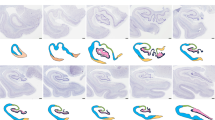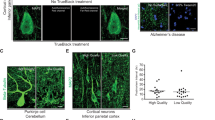Summary
Topographic analysis was performed of the distribution of Alzheimer's neurofibrillary tangles and the granulovacuolar degeneration of Simchowicz in the hippocampal cortex of patients with Alzheimer's dementia and mentally normal aged controls. A semiautomated scanning stage microscope was linked potentiometrically to an XY pen recorder in order to plot cytoarchitectonic “scattergrams” from the sequentially screened hippocampal formations. The density of both lesions per cubic mm of pyramidal cortex was quantified by measuring the area of each of six “zones”, using a digitizer and programmable calculator.
In elderly normal brains as well as those of Alzheimer's disease, the statistically most representative ranking order of predilection forneurofibrillary tangles (in decreasing severity) was: entorhinal cortex > subiculum > H1 > end-plate > presubiculum > H2. Forgranulovacuolar degeneration the best rank order was: subiculum > H1 > H2 > end-plate > entorhinal cortex > presubiculum. The notable similarities of both such orders of predilection to the well-recognized “selective vulnerability” of certain hippocampal neurones in clinical conditions of hypoxia, ischemia and epilepsy suggest some common, focally accentuated cytotoxic mechanism may underlie all these regional predispositions.
Similar content being viewed by others
References
Ball, M. J.: Neurofibrillary tangles and the pathogenesis of dementia: A quantitative study. Neuropath. Appl. Neurobiol.2, 395–410 (1976)
Ball, M. J.: Neuronal loss, neurofibrillary tangles and granulovacuolar degeneration in the hippocampus with ageing and dementia—a quantitative study. Acta neuropath. (Berl.)37, 111–118 (1977)
Ball, M. J., Lo, P.: Granulovacuolar degeneration in the ageing brain and in dementia. J. Neuropath. exp. Neurol.36, 474–487 (1977)
Bowen, D. M., Smith, C. B., White, P., Davison, A. N.: Neurotransmitter-related enzymes and indices of hypoxia in senile dementia and other abiotrophies. Brain99, 459–496 (1976)
Brierley, J. B.: Cerebral hypoxia. In: Greenfield's Neuropathology, pp. 43–85 (eds. W. Blackwood and J. A. N. Corsellis). London: E. Arnold 1976
Coceani, F., Gloor, P.: The distribution of the internal carotid circulation in the brain of the Macaque Monkey (Macaca mulatta). J. comp. Neurol.128, 419–430 (1966)
Corsellis, J. A. N.: The limbic areas in Alzheimer's disease and in other conditions associated with dementia. In: Alzheimer's Disease: A Ciba Foundation Symposium, pp. 37–50 (eds. G. E. W. Wolstenholme and M. O'Connor). London: J. and A. Churchill 1970
Corsellis, J. A. N.: Ageing and the dementias. In: Greenfield's Neuropathology, p. 813 (eds. W. Blackwood and J. A. N. Corsellis). London: E. Arnold 1976
Corsellis, J. A. N., Meldrum, B. S.: Epilepsy. In: Greenfield's Neuropathology, pp 771–795 (eds. W. Blackwood and J. A. N. Corsellis). London: E. Arnold 1976
Davies, P., Maloney, A. J. F.: Selective loss of central cholinergic neurons in Alzheimer's disease. Lancet2, 1403 (1976)
Dayan, A. D.: Quantitative histological studies on the aged human brain. II. Senile plaques and neurofibrillary tangles in senile dementia. Acta neuropath. (Berl.)16, 95–102 (1970)
Drachman, D. A.: Memory and cognitive function in man: Does the cholinergic system have a specific role? Neurology27, 783–790 (1977)
Gallagher, M., Kapp, B. S., Musty, R. E., Driscoll, P. A.: Memory function: evidence for a specific neurochemical system in the amygdala. Science198, 423–425 (1977)
Goodman, L.: Alzheimer's disease: a clinicopathological analysis of 23 cases with a theory on pathogenesis. J. Nerv. Ment. Dis.118, 97–130 (1953)
Herndon, R. M., Coyle, J. T.: Selective destruction of neurones by a transmitter agonist. Science198, 71–72 (1977)
Hirano, A., Zimmerman, H. M.: Alzheimer's neurofibrillary changes: a topographic study. Arch. Neurol.7, 227–242 (1962)
Hooper, W. M., Vogel, F. S.: The limbic system in Alzheimer's disease. Amer. J. Pathol.85, 1–19 (1976)
Jamada, M., Mehraein, P.: Verteilungsmuster der senilen Veränderungen im Gehirn. Arch. Psychiat. Nervenkr.211, 308–324 (1968)
Kim, S. U.: Demonstration of neurofibrillary degeneration induced by anoxia in spinal motor neurons in vitro. Experientia (Basel)27, 264–265 (1971)
Liss, L., Couri, D., Young, E., Ebner, K., Socarras, L.: Facilitation of Alzheimer's dementia by exogenous factors. J. Neuropath. exp. Neurol.35, 372 (1976)
McLardy, T.: Memory function in hippocampal gyri but not in hippocampi. Intern J. Neuroscience1, 113–118 (1970)
Morel, F., Wildi, E.: Contributions à la connaissance des différentes altérations cérébrales du grand âge. Arch. Suisses Neurol. Psychiat.76, 174–223 (1955)
Niklowitz, W. J.: Neurofibrillary changes after acute experimental lead poisoning. Neurology (Minneap.)25, 927–934 (1975)
Nilges, R. G.: The arteries of the mammalian cornu Ammonis. J. comp. Neurol.80, 177–190 (1944)
Perry, E. K., Perry, R. H., Blessed, G., Tomlinson, B. E.: Necropsy evidence of central cholinergic deficits in senile dementia. Lancet1, 189 (1977)
Scharrer, E.: Vascularization and vulnerability of the cornu Ammonis in the opposum. Arch. Neurol. Psychiat.44, 483–506 (1940)
Scheibel, M. E., Lindsay, R. D., Tomiyasu, U., Scheibel, A. B.: Progressive dendritic changes in the ageing human limbic system. Exp. Neurol.53, 420–430 (1976)
Spielmeyer, W.: Zur Pathogenese örtlich elektiven Gehirnveränderungen. Z. ges. Neurol. Psychiat.99, 756–776 (1925)
Stokes, M. I., Trickey, R. J.: Screening for neurofibrillary tangles and argyrophilic plaques with Congo red staining and polarised light. J. Clin. Path.26, 241 (1973)
Tomlinson, B. E., Blessed, G., Roth, M.: Observations on the brains of non-demented old people. J. Neurol. Sci.7, 331–356 (1968)
Tomlinson, B. E., Blessed, G., Roth, M.: Observations on the brains of demented old people. J. Neurol. Sci.11, 205–242 (1970)
Tomlinson, B. E., Kitchener, D.: Granulovacuolar degeneration of hippocampal pyramidal cells. J. Path.106, 165–185 (1972)
Vogt, C., Vogt, O.: Sitz und Wesen der Krankheiten im Lichte der topostischen Hirnforschung und der Variierens der Tiere. J. Psychol. Neurol. (Lpz.)47, 237–457 (1937)
Woodard, J. S.: Clinicopathological significance of granulovacuolar degeneration in Alzheimer's disease. J. Neuropath. exp. Neurol.21, 85–91 (1962)
Author information
Authors and Affiliations
Rights and permissions
About this article
Cite this article
Ball, M.J. Topographic distribution of neurofibrillary tangles and granulovacuolar degeneration in hippocampal cortex of aging and demented patients. A quantitative study. Acta Neuropathol 42, 73–80 (1978). https://doi.org/10.1007/BF00690970
Received:
Accepted:
Issue Date:
DOI: https://doi.org/10.1007/BF00690970




